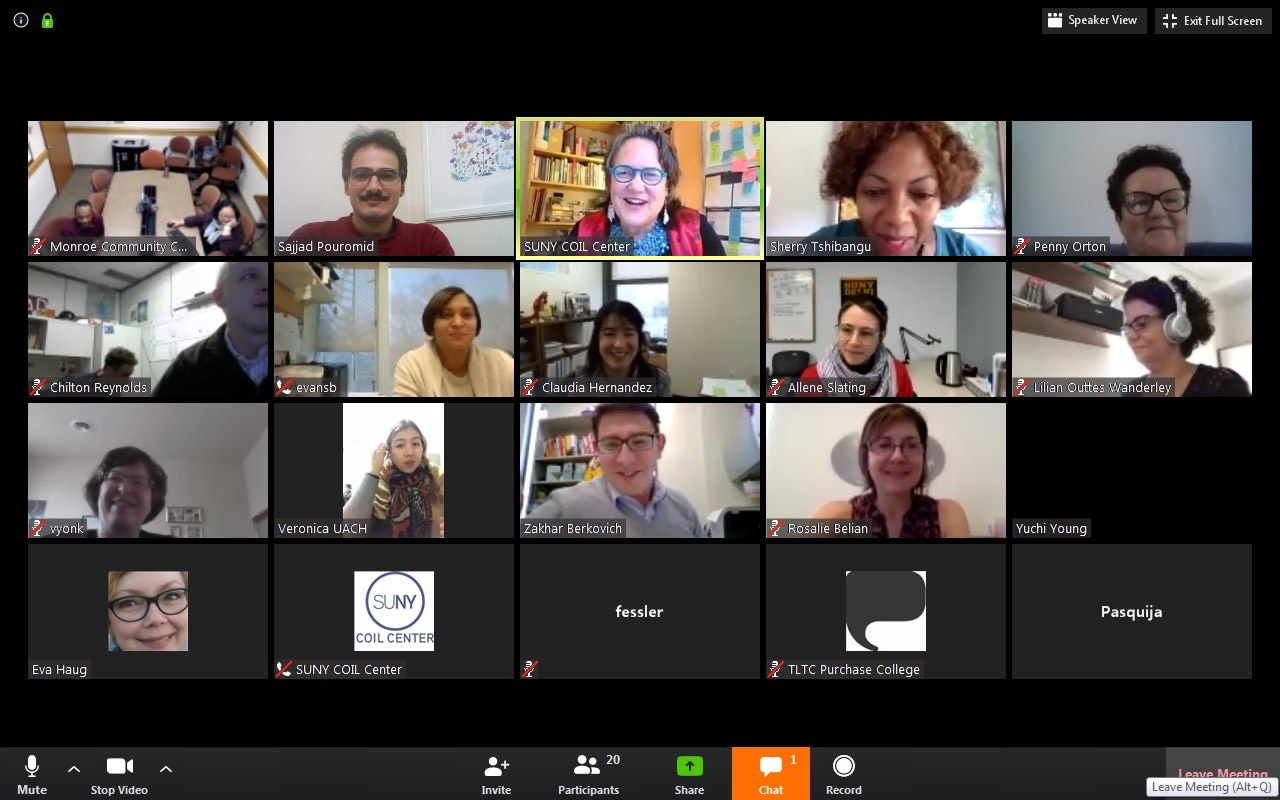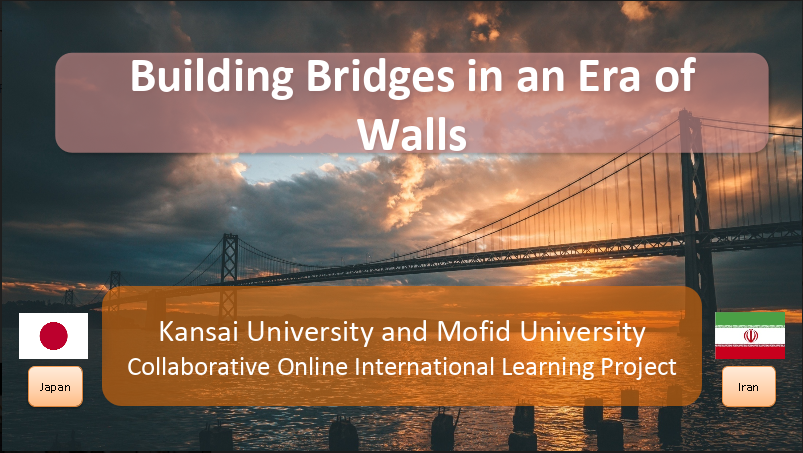2019.12.17ニュース
KU-MU(Mofid University (IRAN) ) COIL : SUNY による大学教員団と学生のプレゼンテーション
12月17日(火)関西大学のSajjad Pouromid教授は各国のCOIL従業者とともにニューヨーク州立大学が開催したウェビナーに参加し、自分たちの学生のプロジェクトを発表し合いました。
本ウェビナーでPouromid教授は現在彼が担当する授業で実施されている関西大学とMofid大学(イラン)間のCOILプロジェクトについて発表しました。教授はプロジェクトの紹介と直面しているイランの制裁規定による技術的な問題について言及した後、本プロジェクトにおける5つの段階、アイスブレイクとなるビデオ作製、文化についての話し合い、ライブ配信での質疑応答の時間、文化的な雑誌の制作、そして自国の文化のプレゼンテーションについて説明しました。最後に、コラボレーションで使用しているプラットフォームやアプリについての質問に答えました。
詳細については以下に記載されています。
KU-MUCOILプロジェクトについてより知りたい方はコチラ→
http://www.kansai-u.ac.jp/Kokusai/IIGE/news/detail.php?seq=62
http://www.kansai-u.ac.jp/Kokusai/IIGE/news/detail.php?seq=59

Building Bridges in an Era of Walls(壁のある時代に橋を架ける)
関西大学、Mofid大学間のCOILプロジェクト
Walls are built here. Walls are built there. Tune in for the latest news and chances are that you learn about new walls being built somewhere. They are built to keep others out. They are built to assure safety for those inside them. They are built by bricks carefully arranged next to each other and joined together using mortar. They are built solid and firm so that no outsider even dares to make an attempt to break in. Bricks are made of clay, which makes them visible from far off. Not all of them are as visible though. Thanks to recent advances in wall-building science and technology, walls can now be built by see-through bricks. Great! Outsiders can now remain outsiders forever without even realizing that. All of this has left education with an important decision to make: whether to be “just another brick in the wall” or to invest more in the seemingly less lucrative business of building bridges to reconnect people and shatter the insidious insider/outsider duality. Breakthroughs in computer-mediated communication and their application in contemporary education have made it easier to make such a decision now compared with any other moment in history. Pretty similar to any other aspect of life in the modern time (or maybe in all times), education has turned into a space for political struggle between those who uphold nationalism and those who favor human emancipation regardless of race, ethnicity, religion, and gender. But how can education support this latter cause? Well, as the old saying goes where there’s a will there’s a way.
Collaborative Online International Learning (COIL) is one such way. Through connecting students in higher education institutions across borders, it has featured enormous potential for building trust, friendship, and cross-cultural understanding. What is more, it has made it possible for the voices of individuals surrounded by multiple rows of walls to be heard. Kansai University’s recent COIL project with Mofid University from Iran provides compelling evidence for this claim. Trapped and squeezed between severe sanctions from the west and the east that limit their access to medicine, technology and quality education among other things, and their own government, which audaciously shuts down the internet entirely for more than a week to silence political protests, the people of Iran have been constantly vying for a chance to engage in constructive dialogue with the world. Beyond a discussion of who is right and who is wrong in the Iran-World dispute, it is the people of Iran who have had to endure a lot. They have the right to be heard. Haruki Murakami, the Japanese writer, once said: “if there is a hard, high wall and an egg that breaks against it, no matter how right the wall or how wrong the egg, I will stand on the side of the egg.” COIL gave us the chance to stand on the side of the fragile egg. Here is a short report of how we did that.
Stage 1: Ice-breaking
Students in both classes were asked to generate questions about the other country. The questions were then randomly assigned to students from the other class, who then introduced themselves in a short video and answered the question given to them. The videos were posted on FlipGrid available to all students to watch and reply to.
Stage 2: Cultural Brainstorming
Students in each class were put into groups and were asked to brainstorm about the culture of the other country and create a mind map of their ideas. Once all mind maps were posted on Padlet, students in the other class were asked to read them and comment on them pinpointing any incident of stereotyping and/or bias. All groups were then asked to revise their mind maps based on the comments they had received.
Stage 3: Live Q & A session
Some of the students from the Iranian class stayed up until 4:00 a.m. to meet their peers from the Japanese class in a Skype meeting and answered their questions regarding different aspects of Iranian culture. Students in the Japanese class took notes to use the information in the subsequent activities.
Stage 4: Cultural Magazine
Students from the two classes were put into mixed-nationality groups and were given two weeks to create a two page cultural magazine about a cultural aspect of their choice comparing Iran and Japan. They were encouraged to exclusively use self-generated visuals in their magazines including photos they could take or illustrations they could draw. The magazine pages were first posted on Padlet and after revisions were made the teachers printed them, put them together and created a magazine.
Stage 5: Cultural Fair Presentation and Reflection
Printouts of the cultural magazine pages were brought to the classes to organize a small Cultural Fair, during which students in each group would pin the pages to the walls around the classroom while other students would go around and listen to their peers’ presentations about them. Finally, students were asked to write a reflection essay on their COIL experience in the semester.
